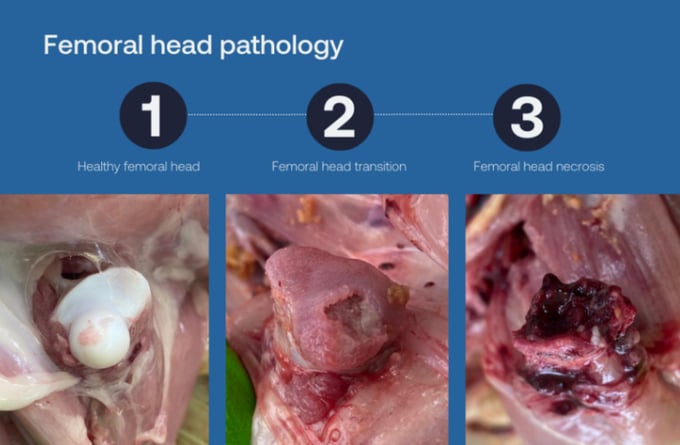November 28, 2025 | 01:23 GMT +7
November 28, 2025 | 01:23 GMT +7
Hotline: 0913.378.918
November 28, 2025 | 01:23 GMT +7
Hotline: 0913.378.918

BCO is often aggravated by secondary factors, such as rickets, caused by imbalances in calcium, phosphorus, or vitamin D levels.
Non-infectious lameness includes conditions like dyschondroplasia (abnormal bone growth), rickets (weak bones due to calcium or vitamin D deficiencies), fractures, and poor nutrition (e.g., lack of choline or biotin). Infectious lameness, on the other hand, is caused by microorganisms like bacteria, but not only and this makes it a very difficult problem to tackle.
One major type of infectious lameness is Bacterial Chondronecrosis with Osteomyelitis (BCO)—a complex condition that stands out as the leading cause of lameness in broilers globally.
BCO is a bacterial infection that affects the bones and joints, particularly those under mechanical stress, such as the femur, tibia, and thoracic vertebrae. These areas are most vulnerable in fast-growing broilers, especially young birds with fragile skeletons.
BCO is widespread, impacting about 1 in every 67 broilers over 30 days of age under normal circumstances. During outbreaks, over 15% of a flock may be affected. In Europe, up to 30% of broilers suffer from painful leg disorders caused by BCO and related skeletal issues, creating both welfare and economic challenges.
BCO is often aggravated by secondary factors, such as rickets, caused by imbalances in calcium, phosphorus, or vitamin D levels. Poor nutrition, chronic gut inflammation, and the destruction of fat-soluble vitamins increase susceptibility. These factors weaken bone development and create ideal conditions for bacterial invasion.
The bacteria responsible for BCO, such as Enterococcus spp., Escherichia coli, and Staphylococcus spp., originate in the gut.
In fast-growing broilers, mechanical stress on bones leads to cartilage damage and inflammation. Damaged areas attract bacteria, which travel from the gut into the bloodstream and settle in joints, multiplying and causing infection.
Young birds are particularly vulnerable because their microbiome is still not established. An immature microbiome and an immature gut tissue makes it easier for harmful bacteria to colonise and consequently transfer into the blood stream.
In some cases, bacteria may also be transmitted vertically from parent stock to chicks.
Treating BCO is difficult, every practitioner can confirm that, and it is due to several factors:
Limited blood flow to cartilage: Bone cartilage has minimal blood supply, making it hard for antibiotics to reach infected areas effectively. Disruption of gut microbiome by antibiotics: While antibiotics can kill harmful bacteria, they also disrupt the gut’s natural balance, delaying the development of beneficial bacteria and leaving room for pathogens to take over. Rapid growth and immature microbiomes: The quick growth of broilers lead to mechanical stress on bones and joints. Simultaneously, their immature intestinal tract and microbiomes heighten their vulnerability to bacterial infections.
The best approach to combat BCO is prevention, focusing on reducing bacterial load, stabilising the gut microbiome, improving intestinal health, and supporting bone and cartilage health. If we really want to have success in preventing BCO, the focus has to be on all of this points.
By implementing these strategies, broiler farmers can significantly reduce the prevalence of BCO, improve bird welfare, and enhance overall productivity. Better gut health and the wright vitamin D supply leads to stronger cartilage and bones, fewer microfractures, and less bacterial spread—ultimately resulting in healthier chickens and fewer cases of BCO.
(Poultryworld)

(VAN) On November 27, in the meeting with Minister Tran Duc Thang, Mayor Yin Yong shared Beijing’s experience to improve environment and air quality.

(VAN) After 30 years, both sides identified strategic areas of cooperation: sustainable production, increasing coffee value and training for farmers.
/2025/11/27/4910-4-164708_294.jpg)
(VAN) On the afternoon of November 27 in Beijing, Minister of Agriculture and Environment Tran Duc Thang held a working session with several major Chinese enterprises operating in the agriculture and environment sector.

(VAN) The Department of Animal Health issued a provisional guideline requesting local authorities to increase surveillance, collect samples for testing, and conduct epidemiological investigations according to the established procedure.

(VAN) The United Nations recommends that Vietnam utilize data and artificial intelligence to enhance early disaster warnings and reduce GDP losses by 3.2% in the context of climate change.

(VAN) On the morning of November 27 in Beijing, Minister Tran Duc Thang and the Deputy Commissioner General of the General Administration of Customs of China signed a protocol on fresh jackfruit exports.

(VAN) As floodwaters recede, a vast network of irrigation works across eastern Gia Lai is emerging in a state of severe disrepair, with extensive damage demanding urgent restoration ahead of the 2025-2026 winter-spring cropping season.